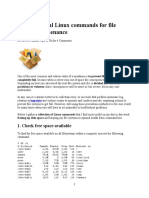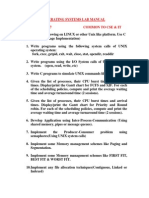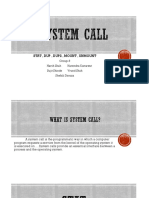Thelinuxstuff - Blogspot.in 2011 12 Interview Linux Question Answers Part 4.HTML
Uploaded by
Shitesh SachanThelinuxstuff - Blogspot.in 2011 12 Interview Linux Question Answers Part 4.HTML
Uploaded by
Shitesh SachanInt erview Linux Quest ion & Answers-PART 4
How to see the f ree memory in Linux? /proc/meminf o / f ree
How you will see a port is opened or not? netstat an |grep LIST EN (or) nmap ipaddress What is Sticky bit ? If the sticky bit is set f or a directory, only the owner of the directory or the owner of a f ile can delete or rename a f ile within that directory T he sticky bit is an access-right f lag that can be assigned to f iles and directories on Unix systems. T he most common use of the sticky bit today is on directories, where, when set, items inside the directory can be renamed or deleted only by the item's owner, the directory's owner, or the superuser (Without the sticky bit set, a user with write and execute permissions f or the directory can rename or delete any f ile inside, regardless of the f ile's owner.)
What are the process states in Unix?
As a process executes it changes state according to its circumstances. Unix processes have the f ollowing states: Running : T he process is either running or it is ready to run . Waiting : T he process is waiting f or an event or f or a resource. Stopped : T he process has been stopped, usually by receiving a signal. Z ombie : T he process is dead but have not been removed f rom the process table.
How do you list currently running process? ps How do you stop a process? kill pid How do you f ind out about all running processes? ps -ag How do you search f or a string inside a given f ile? grep string f ilename How do you search f or a string inside a directory? grep string * How do you search f or a string in a directory with the subdirectories recursed? grep -r string *
How do you check the sizes of all users home directories (one command)? a. du -s df T he du command summarizes disk usage by directory. It recurses through all subdirectories and shows disk usage by each subdirectory with a f inal total at the end.
How do you check f or the httpd.conf consistency and any errors in it? apachectl conf igtest
You might also like
- Mastering Linux Administration: A Comprehensive Guide: The IT CollectionFrom EverandMastering Linux Administration: A Comprehensive Guide: The IT Collection5/5 (1)
- 15 Most Useful Linux Commands For File System MaintenanceNo ratings yet15 Most Useful Linux Commands For File System Maintenance6 pages
- Linux Interview Questions: What Is Kernel? Explain The Task It PerformsNo ratings yetLinux Interview Questions: What Is Kernel? Explain The Task It Performs6 pages
- Linux Commands Cheat Sheet - LinuxForDevicesNo ratings yetLinux Commands Cheat Sheet - LinuxForDevices5 pages
- 01 - Linux ITNSA - Linux Basic Command - OperationNo ratings yet01 - Linux ITNSA - Linux Basic Command - Operation23 pages
- The Kernel Is What Allows The Hardware TNo ratings yetThe Kernel Is What Allows The Hardware T8 pages
- Unit - 5 UNIX / Linux - File System Basics: Directory StructureNo ratings yetUnit - 5 UNIX / Linux - File System Basics: Directory Structure41 pages
- Linux Command Cheat Sheet_ Mastering LinuxNo ratings yetLinux Command Cheat Sheet_ Mastering Linux7 pages
- If You Are Preparing For Interviews For Linux Admin Jobs You Should Be Familiar With Below Concepts.83% (6)If You Are Preparing For Interviews For Linux Admin Jobs You Should Be Familiar With Below Concepts.54 pages
- Q #1) What Is The Description For Kernel?No ratings yetQ #1) What Is The Description For Kernel?20 pages
- Linux System Administrator Interview Questions You'll Most Likely Be AskedFrom EverandLinux System Administrator Interview Questions You'll Most Likely Be AskedNo ratings yet
- Free Open Source Linux OS For Data Recovery & Data Rescue Bilingual Version UltimateFrom EverandFree Open Source Linux OS For Data Recovery & Data Rescue Bilingual Version UltimateNo ratings yet
- Learning Linux Binary Analysis: Learning Linux Binary AnalysisFrom EverandLearning Linux Binary Analysis: Learning Linux Binary Analysis4/5 (1)
- DRBD-Cookbook: How to create your own cluster solution, without SAN or NAS!From EverandDRBD-Cookbook: How to create your own cluster solution, without SAN or NAS!No ratings yet
- Best Free Open Source Data Recovery Apps for Mac OS English EditionFrom EverandBest Free Open Source Data Recovery Apps for Mac OS English EditionNo ratings yet
- Footprinting, Reconnaissance, Scanning and Enumeration Techniques of Computer NetworksFrom EverandFootprinting, Reconnaissance, Scanning and Enumeration Techniques of Computer NetworksNo ratings yet
- Linux for Beginners: Linux Command Line, Linux Programming and Linux Operating SystemFrom EverandLinux for Beginners: Linux Command Line, Linux Programming and Linux Operating System4.5/5 (3)
- Owasp Top 10 Attacks and Mitigation: Detox TechnologiesNo ratings yetOwasp Top 10 Attacks and Mitigation: Detox Technologies25 pages
- Vulnerability (Broken Authentication and Session Management)No ratings yetVulnerability (Broken Authentication and Session Management)4 pages
- Tatement of ORK Emplate: Ompany AME Treet Ddress ITY Tate IP ODENo ratings yetTatement of ORK Emplate: Ompany AME Treet Ddress ITY Tate IP ODE8 pages
- Render Https Sessions Vulnerable Data LeaksNo ratings yetRender Https Sessions Vulnerable Data Leaks16 pages
- Thelinuxstuff - Blogspot.in 2012 07 DNS Server Interview Questions and - HTMLNo ratings yetThelinuxstuff - Blogspot.in 2012 07 DNS Server Interview Questions and - HTML7 pages









































































